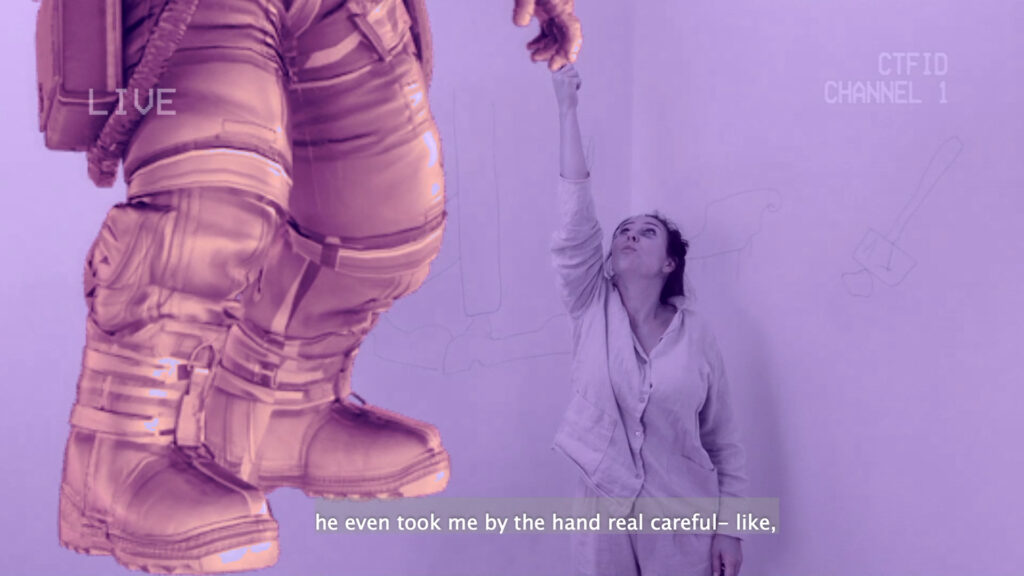
‘State vs. Natasha Banina’ Directed by Igor Golyak, based on Yaroslava Pulinovich’s ‘Natasha’s Dream;’ Performed by Darya Denisova; Translated by John Freedman; Animation by Anton Iakhontov; Video by Igor Golyak; Music composed by Vadim Khrapatchev. Produced by Arlekin Players Theater in partnership with ArtsEmerson and the Cherry Orchard Festival. For upcoming performances, visit arlekinplayers.com/state-vs-natasha-banina-online-interactive-live-performance-2/
by Shelley A. Sackett
If there are silver linings to the COVID-19 pandemic (and I firmly believe there are many), the robust and varied ways in which live theatre has adapted itself to the digital Zoom era ranks at the top of the list. Some have opted to create a virtual replica of the silent, passive invisible spectator model, maintaining a masked cyber wall between actor and audience, with mixed and inconsistent success.
Not so Arlekin Players Theater’s production of ‘State vs. Natasha Banina.’ Under Igor Golyak’s ground-breaking direction, his “live theater and experiment” audience is far from detached and anonymous. Digging deep into his interactive theatrical bag of tricks, Golyak uses graphics, animation and live viewer participation to erase the glass barrier between observed and observer and create a unique film/theater hybrid. The result is one thrilling corona coaster ride.
The 55-minute live production centers on the fate of Natasha Banina (brilliantly played by the 2020 Elliot Norton Award-winner for Outstanding Actress, Darya Denisova), a Russian 16-year-old incarcerated as she awaits trial for manslaughter in a crime of passion. During pre-show remarks, a masked Golyak addresses the spectators with the words, “Welcome to our virtual courtroom.”
The audience/participants (which last Sunday numbered close to 100) are members of the Zoom jury, Golyak says. We are encouraged to introduce ourselves in a pre-show chat room and take an interactive on-line poll to determine our eligibility to serve. The camera remains 2-way throughout the performance, with Natasha periodically addressing the “jurors” by name. The effect is electrifying.
We then enter Natasha’s cell, where we remain with her for the rest of the piece as she takes the virtual stand and testifies on her own behalf. She slowly unfolds her story, peeling back the layers of an onion that brings predictable tears to the eye. Raised in a small-town orphanage by abusive and hard-hearted “caregivers”, she describes a childhood laced with pain, populated by girls who bully each other and a mother who refers to her as “my abortion.” Unflappable, Natasha nonetheless remains optimistic. She has hope for a different future. She has faith in an imaginary pipedream. “Natasha, what is your dream?” she repeatedly asks herself, with increasing desperation and animalistic passion.
Her life went bad, she confides, when a journalist came to the orphanage and, in the course of his research, took a personal interest in her inhumane conditions. He asked her a question no one had ever asked: “What’s your dream, Natasha?”
Natasha misinterprets this single moment of kindness (“It is the first time someone has been horrified for my life,” she says with puppy dog exuberance). She overreacts, and in her delusional and desperate infatuation, imagines him as her knight in shining armor who will marry her and lead her into a fairytale land of forever after. (Under animator Anton Iakhontov’s inspired genius, the knight is replaced by an astronaut who literally leads Natasha to another world amid cartoon hearts and clouds).
As the lines between inside and outside the stark white cell become blurred for the audience, so does Natasha’s grip on reality as she tells us what came next. She paces around the confined space, grinning all the time with a Cheshire catgrin that alternates among bestial, alluring, menacing and achingly vulnerable. Running black eye makeup and a half- blackened tooth amplify the effect.
Trapped by her fantasies, Natasha continues her self-defense. When she spies her imaginary lover with another woman, she becomes unhinged, encouraging her posse to savagely beat her as revenge. The woman remains hospitalized in a coma and for that act, Natasha faces trial.
And we, the Zoom jury, are to decide her fate.
Natasha takes it to an even more personal level as she addresses audience members by name and pleads with them to see her side of the story. “It’s just a dream I had,” she confesses. And with that, an interactive poll appears on the screen and we are asked to vote: guilty or not guilty?
Within seconds, the verdict appears. Last Sunday, Natasha was found guilty. Other nights, she has had more luck.
Denisova’s performance cannot be praised enough. Although she is alone throughout the entire performance, the audience is left wanting more, no small or standard feat. Her physicality is riveting: she prowls, growls, purrs and eventually claws her way into our hearts. Her jagged smile and trapped, beseeching eyes make us want to hug her and tame her, not necessarily in that order.
As engaging as the play was, the almost as long Emerson-facilitated talk-back was equally absorbing, as Golyak and Denisova fielded questions and took us on a tour of the apartment where the performance was filmed. The audience/jury participation in the live chat was rich with insight and nuance as the discussion veered to questions of morality, insanity defense, human pain and suffering, and judgment.
“The virtual medium is just another space where theater takes place and where audiences can share experiences,” Golyak explained. “Theater is one of those art forms that can be represented in many different environments.”
‘State vs Natasha’ has just started its global virtual tour. For more information, go to www.arlekinplayers.com.

